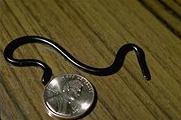Blind snakes facts for kids
Quick facts for kids Scolecophidia |
|
|---|---|
 |
|
| Brahminy blind snake, Ramphotyphlops braminus |
|
| Scientific classification |
|
| Kingdom: | Animalia |
| Phylum: | Chordata |
| Class: | Reptilia |
| Order: | Squamata |
| Suborder: | Serpentes |
| Infraorder: | Scolecophidia Cope, 1864 |
| Families | |
|
See text |
|
The Scolecophidia, often called blind snakes or thread snakes, are a group of snakes. They are usually between 10 and 100 centimeters (4 to 39 inches) long. All of them are fossorial, which means they are great at burrowing underground. There are five main families and 39 different types (genera) of these snakes known today.
Contents
What are Blind Snakes?
Why are they called Scolecophidia?
The name Scolecophidia comes from two ancient Greek words. "Skolex" means "earthworm," and "ophis" means "snake." So, the name basically means "earthworm snake." This name fits them well because of their worm-like shape and their habit of living underground.
Families of Blind Snakes
There are five main families of blind snakes. Each family has its own unique features and lives in different parts of the world.
| Family | Scientist who named it | Number of types (genera) | Common name | Where they live |
|---|---|---|---|---|
| Anomalepididae | Taylor, 1939 | 4 | Primitive blind snakes | Southern Central America and South America |
| Gerrhopilidae | Vidal, Wynn, Donnellan & Hedges, 2010 | 2 | Blind snakes | India, Southeast Asia, Indonesia, the Philippines, and New Guinea |
| Leptotyphlopidae | Stejneger, 1892 | 13 | Slender blind snakes or threadsnakes | Africa, western Asia, and the Americas |
| Typhlopidae | Merrem, 1820 | 18 | Long-tailed blind snakes | Most tropical and many subtropical places worldwide |
| Xenotyphlopidae | Vidal, Vences, & Hedges, 2010 | 1 | Blind snakes | Madagascar |
How Old are Blind Snakes?
Scientists believe that blind snakes first appeared a very long time ago, during the Middle Jurassic period. This was about 174 to 163 million years ago! The oldest known fossil of a blind snake, called Boipeba tayasuensis, was found in Brazil. It lived during the Late Cretaceous period, about 87.8 million years ago. This ancient snake was over 1 meter (3.3 feet) long, which is much bigger than most blind snakes today.
Where Did Blind Snakes Come From?
Scientists think that blind snakes first evolved on a supercontinent called Gondwana. This huge landmass later broke apart into the continents we know today.
The Anomalepididae and Leptotyphlopidae families likely developed in the western part of Gondwana. This area became South America and Africa. The other families, Typhlopidae, Gerrhopilidae, and Xenotyphlopidae, probably evolved in the eastern part. This part included what is now India and Madagascar.
Over millions of years, these snakes spread to new places. For example, typhlopids traveled from Africa to Eurasia. Some even crossed the Atlantic Ocean from Africa to South America about 60 million years ago! From South America, they then spread to the Caribbean islands. Typhlopids also reached Australia from Southeast Asia or Indonesia about 28 million years ago.
What Do Blind Snakes Look Like?
Blind snakes get their common name because their eyes are very small and covered by head scales. These scales are opaque, meaning you can't see through them very well. This makes their eyesight very poor. Scientists think that early snakes might have lived underground, which caused them to lose some of their eyesight genes. Later, other types of snakes developed better eyesight again.
Most blind snakes have a slender, cylindrical body shape. Their heads are small and narrow, which helps them burrow through soil. Most of these snakes also have only one working lung (the right one), or a very small left lung. They also don't have special heat-sensing pits on their heads like some other snakes.
How Do Blind Snakes Live?
The most important thing about all blind snakes is that they are fossorial. This means they spend most of their lives underground, or hidden in logs and piles of leaves.
Scientists are still learning about how these snakes reproduce. So far, all blind snakes that have been studied lay eggs. Their eggs are often long and thin.
Blind snakes eat invertebrates, which are creatures without backbones. Their favorite foods include ant and termite eggs. They find these eggs by following chemical trails left by the insects. One type of blind snake, Tricheilostomata macrolepis, has even been seen climbing trees. It waves its head from side to side to sniff out insect nests in the air!
Some blind snakes are picky eaters and only eat termites or ants. Others might eat a lot of food all at once, like a big feast. It's often hard to find these snakes because they live underground. But after it rains, you might see them above ground. This is because their burrows can get flooded.
Because blind snakes are so ancient, they help scientists understand how snakes have changed and evolved over millions of years. They are like living fossils that teach us about snake reproduction, body shapes, and eating habits.
Images for kids
-
Brahminy blind snake,
Ramphotyphlops braminus
See also
 In Spanish: Scolecophidia para niños
In Spanish: Scolecophidia para niños


